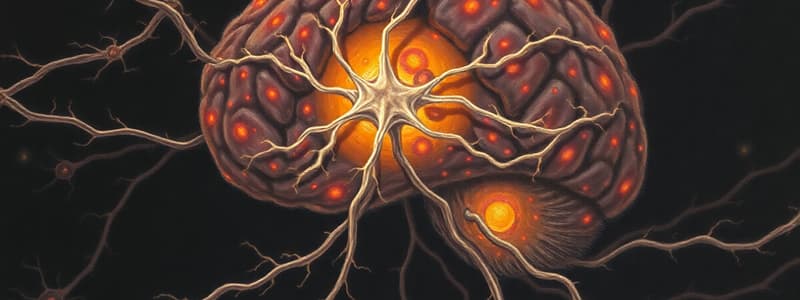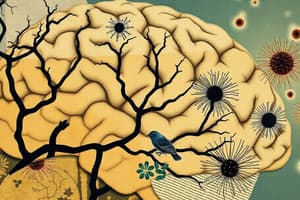Podcast
Questions and Answers
What is the primary function of neurons in the nervous system?
What is the primary function of neurons in the nervous system?
- To receive, integrate, and transmit information (correct)
- To provide structural support to other cells
- To store energy for cellular processes
- To facilitate blood flow to the brain
Which part of a neuron is primarily involved in signal transmission?
Which part of a neuron is primarily involved in signal transmission?
- Soma
- Synapse
- Dendrite
- Axon (correct)
Which of the following describes the function of dendrites?
Which of the following describes the function of dendrites?
- Protecting the neuron from damage
- Signal transmission to other neurons
- Production of neurotransmitters
- Information reception from other neurons (correct)
What is the role of glial cells in the nervous system?
What is the role of glial cells in the nervous system?
What characterizes bipolar neurons?
What characterizes bipolar neurons?
Which component of the neuron is responsible for integrating incoming signals?
Which component of the neuron is responsible for integrating incoming signals?
What is a unique feature of unipolar neurons?
What is a unique feature of unipolar neurons?
What is the axon hillock's significance in a neuron?
What is the axon hillock's significance in a neuron?
What role do sensory (afferent) neurons primarily serve in the nervous system?
What role do sensory (afferent) neurons primarily serve in the nervous system?
Which type of neuron is primarily responsible for connecting two neurons within the central nervous system?
Which type of neuron is primarily responsible for connecting two neurons within the central nervous system?
What is the primary function of myelinated neurons in the nervous system?
What is the primary function of myelinated neurons in the nervous system?
What is the role of mitochondria in neurons?
What is the role of mitochondria in neurons?
Which of the following statements about myelination is correct?
Which of the following statements about myelination is correct?
What is the main energy-consuming process that neurons engage in?
What is the main energy-consuming process that neurons engage in?
Which parts of the neuron are typically not myelinated?
Which parts of the neuron are typically not myelinated?
What distinguishes motor (efferent) neurons from sensory (afferent) neurons?
What distinguishes motor (efferent) neurons from sensory (afferent) neurons?
What role do microglia play in the central nervous system (CNS)?
What role do microglia play in the central nervous system (CNS)?
Which of the following functions are NOT performed by astrocytes?
Which of the following functions are NOT performed by astrocytes?
What is the function of Schwann cells in the peripheral nervous system (PNS)?
What is the function of Schwann cells in the peripheral nervous system (PNS)?
Which cells in the PNS provide structural support to neuron cell bodies?
Which cells in the PNS provide structural support to neuron cell bodies?
How do microglia contribute to the immune response within the CNS?
How do microglia contribute to the immune response within the CNS?
What is the role of the nodes of Ranvier in myelinated axons?
What is the role of the nodes of Ranvier in myelinated axons?
Which type of glial cell is responsible for myelinating peripheral nervous system neurons?
Which type of glial cell is responsible for myelinating peripheral nervous system neurons?
What is the primary effect of demyelination on signal transmission?
What is the primary effect of demyelination on signal transmission?
How does myelination affect ion movement in neurons?
How does myelination affect ion movement in neurons?
What is the process called in which electrical impulses 'jump' along a myelinated axon?
What is the process called in which electrical impulses 'jump' along a myelinated axon?
Which of the following glial cells produce cerebrospinal fluid?
Which of the following glial cells produce cerebrospinal fluid?
What happens to the myelin sheath in demyelinating diseases?
What happens to the myelin sheath in demyelinating diseases?
What effect does myelination have on the capacitance of an axon?
What effect does myelination have on the capacitance of an axon?
Flashcards are hidden until you start studying
Study Notes
Nervous System: Cells
- The nervous system is composed of neurons and glial cells.
- Neurons transmit information via electrochemical signaling.
- Glial cells provide support to neurons.
- Some glial cells, like oligodendrocytes and Schwann cells, modify neurons by providing myelin, an electrically insulating layer.
Neuron Structure and Function
- Neurons are specialized for receiving, integrating, and transmitting information.
- Neurons have three main parts:
- Soma: Cell body containing the nucleus and participating in information reception and integration.
- Dendrites: Neuron extensions specialized for signal reception.
- Axons: Neuron extensions specialized for signal transmission.
- Axon hillock: Region where the axon originates from the soma.
- Axon terminal: End of the axon, where signal transmission occurs.
- Neurons can be classified based on their morphology:
- Bipolar neurons: Single dendrite and a single axon.
- Multipolar neurons: More than one dendrite and a single axon.
- Unipolar neurons: Cell body located to the side of a single extension formed from the fusion of a dendrite and axon.
- Neurons can also be classified based on their function and location:
- Sensory neurons (afferent): Transmit information from the periphery to the CNS.
- Motor neurons (efferent/somatic): Transmit signals from the CNS to the periphery.
- Interneurons: CNS neurons connecting two neurons.
Myelin Sheath
- Myelinated neurons have an electrically insulating sheath called myelin around their axons.
- Unmyelinated neurons lack this layer.
- Myelin consists of multiple layers of a glial cell phospholipid membrane wrapped around the axon.
- Myelination alters ion and nutrient transport along axons.
- Myelinating cells provide nutrients to myelinated regions.
- The myelin layer is interrupted at small, regularly spaced sites called the nodes of Ranvier, which are rich in ion channels.
- Myelination causes electrical impulses to "jump" along the axon, a process known as saltatory conduction.
- Oligodendrocytes: Myelinate CNS neurons.
- Schwann cells: Myelinate PNS neurons.
Glial Cells
- Glial cells provide support, protection, and optimization of neuronal impulse transmission.
- Ependymal cells: Line CNS compartments, forming a barrier and producing cerebrospinal fluid.
- Oligodendrocytes: Myelinating cells in the CNS.
- Microglia: Immune cells in the CNS that can transform into macrophages to phagocytose pathogens and damaged cells.
- Astrocytes: Network of cells connected by gap junctions that perform diverse roles:
- Regulate blood flow.
- Form the blood-brain barrier.
- Regulate chemical composition near synapses.
- Exchange metabolic substrates with neurons.
- Schwann cells: Myelinating cells in the PNS.
- Satellite cells: Nonmyelinating Schwann cells in the PNS that provide structural support and nutrients to neuron cell bodies.
Studying That Suits You
Use AI to generate personalized quizzes and flashcards to suit your learning preferences.




